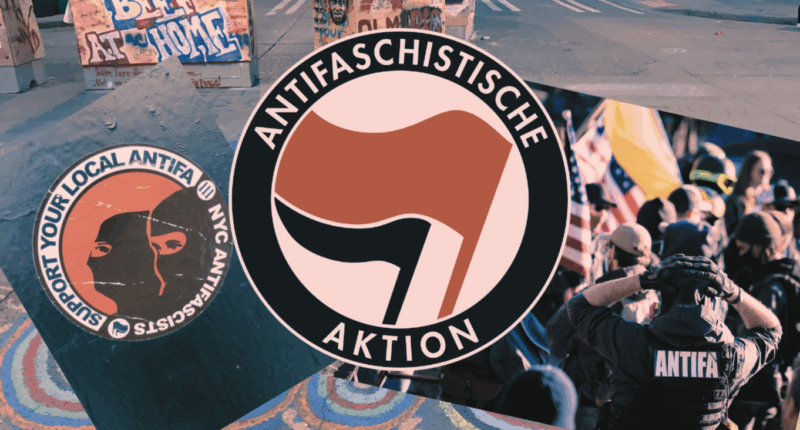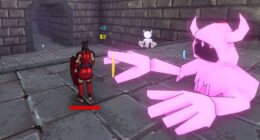In the wake of President Donald Trump designating Antifa a domestic terror organization, the corporate media have been quick to critique the move and question the feasibility and constitutionality of taking corresponding action. But an exploration of Antifa’s recent record of identity-obsessed violence and the dark history of its Marxist antecedents reveals an urgent need to counter the vicious left-wing movement.
Antifaschistische Aktion
The modern Antifa movement has its roots in the communist paramilitary arm that operated in Germany during the tumultuous years of the Weimar Republic: Antifaschistische Aktion. The Soviet-directed Communist Party of Germany (Kommunistische Partei Deutschlands — KPD) founded Antifaschistische Aktion in 1932, and historian William L. Shirer provides a window into the bloody nature of the conflict taking place in Germany’s streets in that year: “The storm troopers swarmed the streets seeking battle and blood and their challenge was often met, especially by the Communists. In Prussia alone between June 1 and 20 there were 461 pitched battles in the street which cost eighty-two lives and seriously wounded four hundred men.”
Yet the conclusion that Antifaschistische Aktion operated only to save Germany and Europe from Adolf Hitler’s National Socialists would be spurious. Instead, the original Antifa acted with “the explicit purpose of using street violence to disrupt the ability of Germany’s political center — the democratic liberals, moderates, and conservatives — to organize during the waning days of the Weimar Republic,” as Kyle Shideler, director and senior analyst for Homeland Security and Counterterrorism at the Center for Security Policy, has noted. Far from limiting their activity to opposing the Nazis, German communists (who had engaged in their own efforts to overthrow the government) also “denounc[ed] socialists as ‘social fascists’ more dangerous than the real ones.” Moreover, Antifa was called the “decisive weapon” in one of the communists’ battles with the Social Democrats, Germany’s oldest political party. The original Antifa was engaged in a death struggle for power, not against tyranny, a death struggle between communism and fascism that would burst forth into total war with the launch of Operation Barbarossa and culminate in the fall of Berlin in 1945.
Red Terror in Europe
Though the fall of Hitler and Benito Mussolini and their fascist regimes would leave communists without an incarnated fascist foil and Antifa without a direct successor, the construct of anti-fascist action was alive and well, and numerous organizations would follow in the violent communist footsteps of Antifaschistische Aktion. During the Cold War, the East German Communists would call the Berlin Wall the “Antifascistischer Schutzwall,” or “antifascist bulwark,” and the Soviet Union weaponized the term “fascist” not to delineate “a stable set of characteristics” but to label its “most prominent or hostile enemy in any given context.”
In Italy, the Red Brigade, launched in 1970, perpetrated “about 50 attacks, in which nearly 50 people were killed” from 1974 to 1988. With roots in the “1960s worker and student
protest movements,” the Red Brigade waged war against the “right-wing political bourgeoisie” to bring about a Marxist revolution. The group’s ideology was so obviously violent and left-wing that Red Brigadist Patrizio Peci noted that one did not join the Brigade “if one does not believe completely in Communism, if one does not believe in the armed struggle as the only way to bring it about, if one does not believe in victory.”
The Red Brigade would ultimately fail, but not before abducting and then assassinating former Prime Minister Aldo Moro in 1978 after holding him for nearly two months. In 1981, four Red Brigade terrorists who presented themselves as plumbers kidnapped NATO Deputy Chief of Staff General James Dozier, though Italian police rescued Dozier after more than 40 days in captivity. Red Brigade communists were known for “kneecapping” opponents they chose not to kill by putting a bullet through each knee, disabling the victims for life.
As the Brigade’s left-wing terror spree kicked off in Italy, the Red Army Faction (or Baader-Meinhof Group) was on the rise in West Germany. Originating in student protests and backed by the East German Stasi, the RAF targeted high-profile businessmen, politicians, and other public figures in its “anti-fascist” war on West German capitalism and U.S. “imperialism.” The RAF’s radical leftists bombed, shot, and kidnapped their way through the ’70s and ’80s before finally collapsing in 1998 — having killed at least 34 people, collaborated with Palestinian terrorists to hijack an airliner, and laid siege to the West German embassy.
The communist RAF did garner the attention of atheist philosopher Jean-Paul Sartre, one of the most influential thinkers of the 20th century. After Sartre reportedly pontificated that the RAF was an “interesting force” that had “a sense for the Revolution,” the left-wing terrorist organization suggested Sartre should meet with the imprisoned Andreas Baader. The meeting was controversial at the time, but it would be nearly 40 years before the transcript was released. In that transcript, Sartre tried to alter Baader’s course, but he also rationalized the RAF’s violent actions, saying they “might be justified for Brazil, but not for Germany.” In Brazil, after all, there was a different type of “proletariat.”
Sartre’s attitude is unsurprising, given his radical moral relativism and his enthusiastic support for political violence. In the foreword to Frantz Fanon’s The Wretched of the Earth, Sartre infamously wrote that “this irrepressible violence … is man re-creating himself,” and “to shoot down a European is to kill two birds with one stone.” “Fanon’s view,” in the words of The New Yorker, was that “the Western bourgeoisie was ‘fundamentally racist’ and its ‘bourgeois ideology’ of equality and dignity was merely a cover for capitalist-imperialist rapacity” — apt summaries of the ideology that animates the modern left and the modern Antifa movement.
Weather Underground, Punk, and the Rise of American Antifa
In the United States, today’s Antifa has numerous forerunners, among whom is the Weather Underground, which executed a number of the 2,500 bombings that were perpetrated in a year-and-a-half period in the early 1970s. Notably, Weather Underground members Kathy Boudin and David Gilbert are the parents of radical leftist prosecutor Chesa Boudin, and fellow Weather Undergrounders Bill Ayers and Bernardine Dohrn raised the younger Boudin. (Ayers was also instrumental in Barack Obama’s entry into politics, and his adopted son Chesa Boudin was elected D.A. of San Francisco, where he was recalled for refusing to prosecute crime.)
The May 19th Communist Organization (MCO) and its “front” group, John Brown Anti-Klan Committee, are another prominent example, engaging in or promoting street fighting, robberies, bombings, and pro-communist propaganda in the late ’70s and early ’80s.
Meanwhile, as Shideler describes,
In 1980s Germany, Antifa honed new tactics as it took part in clashes between police and student squatters. These squatters were devotees of autonomism, an anarcho-Marxist ideology influenced by the previous generation’s Communist guerillas. German Autonomen were the pioneers of the now-infamous “black bloc” street-fighting tactics, in which rebels would block off and then passionately defend their self-styled “autonomous zones.” Black bloc action remains the basis for Antifa’s modern campaigns, as exemplified in the notorious Capitol Hill Autonomous Zone (CHAZ) in downtown Seattle in the summer of [2020]. This strategy is what allowed Antifa to transfer effectively into the British cities, and from there to the United States.
In a 2020 RealClearInvestigations report, The Federalist’s Mark Hemingway observed that Antifa in the United States has “drawn power from punk-rock subcultures and post-1960s left-wing extremism.”
After white supremacists recruited disaffected youths as “skinheads” and racist “Oi” bands began to appear, counter-movements formed in response. In particular, a group of punk rockers known as the Minnesota Baldies in 1987 formed the Anti-Racist Action Network (ARA) to engage in “direct action” confrontations using spray paint, crowbars, and bricks against racists in the punk scene. Word of the group and its exploits, which sometimes involved violent skirmishes with racists, spread via underground punk publications known as “zines” and the organization spread across the country.
According to a CNN report, “Large numbers of Antifa activists first appeared in the United States at anti-World Trade Organization protests in 1999 in Seattle, and then more recently during the Occupy Wall Street movement.” As Hemingway noted, the first group to take up the mantle “Antifa” surfaced in Boston in 2002, and in 2013, the Torch Antifa network formed, eventually becoming “one of the largest regional networks of Antifa in the United States.” By 2017, Antifa groups were reportedly showing up at pro-Trump rallies, the “Unite the Right” gathering in Charlottesville, and college campuses in protest of speakers they opposed, while being “involved in clashes across the country and the world, including in Chicago, Philadelphia, Houston, Alabama and Nebraska, and at the G20 summit in Hamburg, Germany” shortly after.
Identity-Obsessed Violence
Since bursting onto the national scene, Antifa members — to give just a few examples — have engaged in countless street “actions” that involve violence, intimidation, manipulation, scare tactics, and mistreatment of law enforcement, journalists, and demonstrators. Antifa has shut down events, vandalized homes, political headquarters, and government buildings, taken to the streets with weapons, and destroyed property. In 2019, a “self-proclaimed” Antifa radical and John Brown Gun Club member assaulted an ICE facility with an AR-15 and tried to blow up a “500-gallon propane tank.” In 2020, a self-professed Antifa member allegedly shot an opposing protestor — and was wanted for murder before he himself was killed by law enforcement when he “attempted to escape arrest and produced a firearm,” according to then-Attorney General William Barr. In 2022, Antifa agitators in Portland allegedly disrupted a GOP candidate’s rally with smoke grenades, paint-filled balloons, and fireworks. Suspected Antifa members allegedly ambushed ICE officers in July of this year, shooting one police officer in the neck. Charlie Kirk’s alleged assassin wrote antifascist messages on his ammunition.
Antifa’s use of political violence, force, and intimidation offers compelling proof that it is the ideological successor of Antifaschistische Aktion and its progeny, from the Red Army Faction to the Weather Underground. The willingness to engage in violence flows directly from the Marxist ideology Antifa holds in common with its predecessors. Karl Marx pitted the proletariat inevitably and intractably against the bourgeoisie and predicted that the “expropriators” would be “expropriated” — a prediction “hypnotic in its promise of apocalyptic revolutionary violence,” in the words of historian Sean McMeekin. The communists of the 20th century would make good on that promise — with casualty totals in the tens of millions — and Antifa threatens to do so again.
Modern Antifa remains as committed as its predecessors to painting its opponents as fascists and opposing capitalism, but its wheelhouse is found in exploiting the oppressor-oppressed matrix to victimize its enemies while simultaneously claiming victim status. This latter point explains Antifa’s obsession with identity, whether identity based on race as capitalized on in the Black Lives Matter riots of 2020, or the identity of illegal immigrants as those exploited by Western colonialism or climate change, or the identity of trans-identifying individuals as those supposedly wronged by the traditional family and Judeo-Christian ethics. Within the oppressor-oppressed matrix, white people, ICE (and American citizens more generally), and Christians — particularly those with some kind of political involvement — become the “fascists” at whom Antifa aims its direct actions in defense of people of color, immigrants, and those who identify as LGBT.
Predictably, the corporate media and Democrats are largely favorably disposed toward Antifa, and when confronted with evidence of Antifa members’ violent actions or the Trump administration’s designation of Antifa as a terrorist organization, they dismiss the movement as an idea, too ethereal to grasp or define. Antifa, the media would have Americans believe, “just means the opposition to fascism.” It’s more “a political scapegoat, honestly,” than a “genuine security threat.”
Aside from mere dismissiveness, media have downplayed the danger posed by Antifa (and left-wing political violence more generally) in two notable ways: First, they have constitently demonized ICE and immigration enforcement, thus presenting anti-ICE assaults as expected and justified; and second, they have painted Charlie Kirk as a itinerant con man and provacateur who deserved the hate leftists heaped on him, rather than as a man who was a conservative statesman, the founder of what is perhaps the right’s most important organization, and a potential presidential candidate.
If the Antifa movement is allowed to fester in American public life, however, an escalation of its violent tactics — assassination, assault, abduction, anarchy — in the pattern of the communist terror groups who have gone before it is not only possible but inevitable. If Antifa is to be defeated, its godless utilitarianism and Marxist identity-obsession that excuses in advance any and every action taken by the “oppressed” against the “oppressor” must be entirely rejected.
Joshua Monnington is an assistant editor at The Federalist. He was previously an editor at Regnery Publishing and is a graduate of Midwestern Baptist Theological Seminary.









